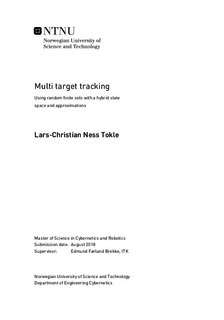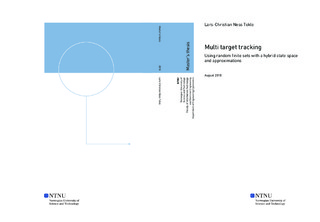| dc.description.abstract | This study provides a thorough investigation into the theoretical framework and background around the standard model used in \ab{mtt}, including \abp{pgm} with \ab{bp}, Bayesian state estimation for a hybrid state space, \abp{rfs} and labeling of sets in their union and the \ab{kldiv}. This serves as a foundation for developing novel derivations of the \ab{pmbm} filter and for how to include a hybrid state space. The models in the \ab{imm} are viewed as a discrete state in the hybrid state space. This enables appropriate conditioning and thus it is possible to avoid the increase in computational complexity of having the discrete states in the data association.
Through the derivations it is seen that the components of the target set, i.e. the underlying sets in the union, can be handled independently under a given association. This is used through the prediction and update step to provides track continuity, and hence the possibility for track labeling. Additionally, track labels are seen as being a latent variable pointing to individual sets, being either a single track set or the undetected targets set, in the unionized set of targets. The track labels follow a specific track after first detection, and hence in a manner provide target identities. The only change in the multi target distribution is in the distribution of the union, and no changes are made to the individual distribution components in this union. The only thing changed in the distribution of the union is the addition of a "labeled subset extractor". Thus, it is seen as being a different approach than the labeling done in the \ab{lmb}.
A total target information distribution is stated as a compact way of viewing the complete picture within \ab{mtt}, and furthering insight into identities and tracks. It might lend itself as a starting point for studies of new approximative algorithms on \abp{pgm}. Furthermore, the relationship to most of the well known \ab{mtt} filters, including \ab{pmbm}, \ab{mht}, \ab{tombp}, \ab{jipda} with its degenerate cases and \ab{phd}, are provided, recognizing them as approximations of the \ab{pmbm}, or as attaining association variables within their distribution. The \ab{lbp} way of approximating the association probabilities of \citeauthor{Williams2014} is given. Lastly it is shown how much larger the expected number of undetected targets is compared to the expected number of born targets after convergence, as a function of model parameters, along with the relationship between new born targets and clutter in the case of constant initial probability. | |

